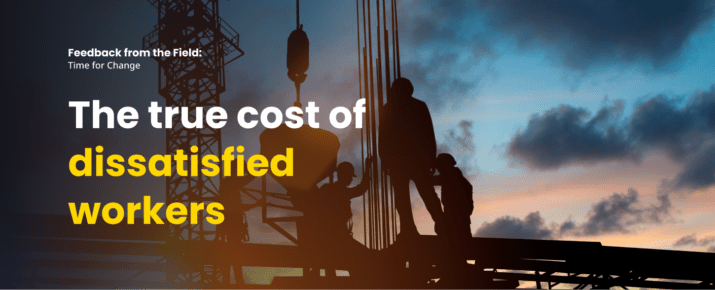Dissatisfied Workers Cost Frontline Businesses approx. $USD 196 Billion* a year in Lost Productivity
Feedback From The Field | Media Release | By | 22 Oct 2024 | 5 minute read

Global report reveals critical gaps in frontline workforce management
SYDNEY – 22 October, 2024: Global technology company, SafetyCulture, has released its fourth annual Feedback from the Field report that highlights a challenging period of change for frontline industries, with a stretched workforce battling fractured workplace relationships, inefficient tools, and a shrinking skills pipeline.
‘Feedback from the Field: Time for Change‘ is one of the largest global studies on the frontline workforce, surveying more than 10,000 employees and managers across Australia, the UK, the US, Germany, France and Ireland. It provides a pulse check on the sentiment and challenges within the critical industries powered by 2.7 billion deskless workers globally.2
Workers are feeling overworked and frustrated with inaction on issues
The majority (78%) of workers are dissatisfied with some aspect of their job. Among these, the primary reasons are slow responses to resolving issues or risks (40%), unreasonable expectations leading to burnout (35%), and pressure to cut corners to save time or money (32%).
When workers are unhappy, performance takes a hit. Of workers who admit to dissatisfaction impacting their performance, 44% feel less motivated, 34% report reduced productivity and 31% say they’re more likely to quit and find another job – this rises to 35% among these Gen Z workers.
On average, workers lose about 7 hours a month due to dissatisfaction, which may show up as unproductive downtime, errors, or absenteeism. The collective impact of this discontent is costing frontline businesses an estimated $USD 196 billion1 annually – dubbed the “Dissatisfaction Dollar.”
“Them vs. us” – a divide between management and the frontline
Focusing on the construction, retail, manufacturing, mining and energy, logistics, and hospitality sectors, the study reveals a concerning disconnect between management and frontline employees. About half of both groups (50% of employees and 55% of managers) agree there is a “them versus us” mentality between those on the tools and those off them. When asked about various aspects of work, communication from management (38%) and overall management performance (34%) are among factors that frontline employees express most dissatisfaction with.
Sam Byrnes, Chief Product Officer at SafetyCulture, says, “Frontline workers are telling us they feel unheard, overstretched, and compromised. On top of this, there is a strained relationship between employees and management that isn’t conducive to a healthy workplace culture or optimal outputs.
“There will always be room for improvement within organisations, but leaders are doing themselves, and their people, a huge disservice by failing to understand frontline challenges, acknowledging and addressing issues, and communicating adequately.
“It’s time businesses woke up to the fact that listening to people on the frontline is one of the fastest ways to improve the bottom line.”
While the relationship between frontline employees and management shows some cracks, the research explores ways to help repair them – and it’s apparent that money talks. Of workers who believe the relationship between the frontline and management could be improved, over half (55%) say better pay and benefits would help. This rises to 61% among frontline employees, compared with 46% in management roles.
The current socio-economic environment could be contributing to the importance placed on better pay and benefits. Three-quarters (76%) of workers with concerns about the future cite the rising cost of living as a worry – the most common concern across all regions surveyed. Looking beyond remuneration, workers who believe the relationship between the frontline and management could be improved say that recognition for strong performance (47%), more regular communication (46%), and, once again, acknowledging and actioning feedback (40%) would help improve the relationship.
Outdated and unfit tools & IT systems are causing a productivity roadblock
Despite hype – and fear-mongering – around new technologies, most workers appear unfazed by their potential impact. Only 34% of those with concerns about the future cite emerging technologies, such as AI, as one of them. In last year’s Feedback from the Field report, 40% of respondents ranked AI among their top three concerns, potentially suggesting growing familiarity or comfort with the technology over the past year.
While workers aren’t expressing much concern about new technologies, they are frustrated by outdated tools that hinder their efficiency. Nearly two-thirds (63%) of workers are not fully satisfied with their current tools and IT systems. Of these, more than one-third (36%) are dissatisfied with outdated tools and systems, 31% with tools that are unfit for purpose, and 29% with insufficient training on how to use them.
Ineffective tools and IT systems not only frustrate workers but also reduce productivity by slowing processes and causing unnecessary downtime. On average, workers lose almost 6 hours a month due to the impacts of ineffective tools and IT systems. This inefficiency costs frontline businesses worldwide a staggering estimated $USD 162 billion3 annually.
“Workers are only as effective as their tools. That’s why we’ve gathered insights from the frontline at every step of developing the SafetyCulture platform, helping us build an accessible, mobile-first platform that, above all else, meets worker’s true needs.
“These tools give onsite teams the knowledge, tools, and confidence to work safely, meet higher standards, and improve every day. It’s the power of improvement in their hands.”
A brain drain looms due to skills shortages
Outside of the workplace, macro conditions are also weighing on workers’ minds. Nearly three in five (57%) workers believe their industry will suffer a brain drain in the future, and 71% of workers believe that skills and labor shortages will present critical issues in their industry. Nearly one-third (31%) of these workers say these shortages are already presenting critical issues, and an additional 39% believe these problems will occur within just three years.
“Workers across the globe are experiencing a huge amount of change. Rising living costs, shrinking skills pipelines and new technologies like AI, just to name a few, are demanding transformation. Even though this time is filled with uncertainty, it’s ripe with opportunity to build organizations that don’t just survive, but thrive in the future,” Byrnes concludes.
For more information and to download the full report, visit https://safetyculture.com/feedback-from-the-field-time-for-change/
Ends
Media enquiries: press@safetyculture.io
* The cost of dissatisfaction to business
This figure was calculated by YouGov based on the average local weekly wage, estimated average hours lost to effects of dissatisfaction as reported by survey respondents, and the estimated number of workers in frontline industries.
Local wage estimates were sourced from national statistical agencies, and the number of worker estimates were sourced from YouGov Profiles.
2 Emergence (2020). The State of Technology for the Deskless Workforce.
3 The cost of ineffective tools and IT systems to business
This figure was calculated by YouGov based on the average local weekly wage, estimated average hours lost to ineffective tools and IT systems as reported by survey respondents, and the estimated number of workers in frontline industries.
Local wage estimates were sourced from national statistical agencies and the number of workers estimates were sourced from YouGov Profiles.
About the research
All figures, unless otherwise stated, are from YouGov. Total sample size was 10,128 adults (N = 2023 UK, 2087 US, 2010 Australia, 2003 Germany, 1504 France, 501 Ireland). Fieldwork was undertaken between 31 July – 14 August 2024. The survey was carried out online. The sample comprised workers aged 18+ (full or part-time) in construction, manufacturing, retail, hospitality, distribution/logistics/supply/transport and energy/mining/resources businesses (excluding sole traders).
About SafetyCulture
SafetyCulture is a global technology company that helps frontline teams find a better way of working. Its mobile-first workplace operations platform gives teams the knowledge, tools and confidence they need to meet higher standards, work safely and improve every day.
The SafetyCulture platform powers over a billion checks each year, delivers approximately 85,000 lessons per day and informs millions of corrective actions. SafetyCulture gives leaders visibility and workers a voice in driving safety, quality, and efficiency improvements.
An analysis by Forrester found that SafetyCulture’s flagship products provide a 214% return on investment for customers and $3.6M in cost savings from operational improvements. Customers of SafetyCulture’s award-winning products include the likes of Coles, Marriott, Toyota and the United Nations.
Important Notice
The information contained in this article is general in nature and you should consider whether the information is appropriate to your specific needs. Legal and other matters referred to in this article are based on our interpretation of laws existing at the time and should not be relied on in place of professional advice. We are not responsible for the content of any site owned by a third party that may be linked to this article. SafetyCulture disclaims all liability (except for any liability which by law cannot be excluded) for any error, inaccuracy, or omission from the information contained in this article, any site linked to this article, and any loss or damage suffered by any person directly or indirectly through relying on this information.




